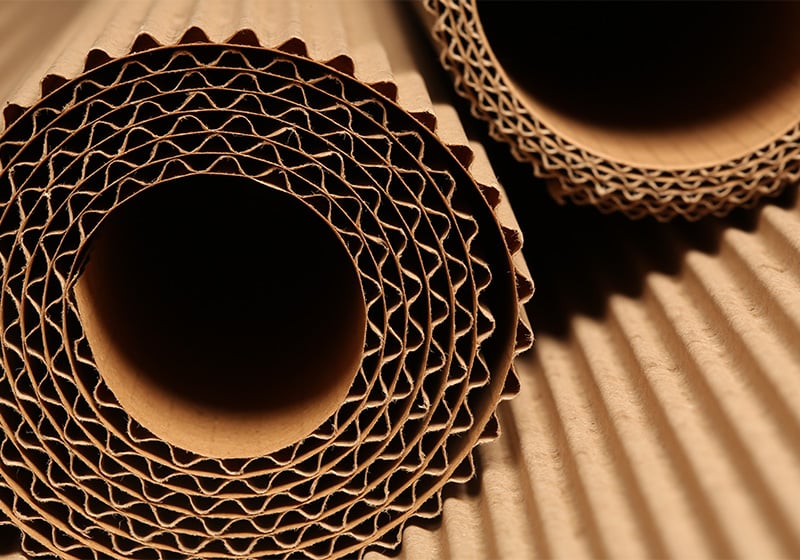Table of Contents
Corrugated cardboard is a material widely used for packaging all sorts of products, from food to cosmetics, clothing to gadgets. Strong, light and sustainable, corrugated cardboard is also used for window dressing, creating indoor signage and producing affordable and portable indoor furniture.
Let’s find out how this material is produced and the different types available.
How is corrugated cardboard made?
In its simplest form (single wall), corrugated cardboard is made from two flat sheets of cardboard, called linerboards, which enclose a fluted sheet, called a flute. These three components are bonded together using a plant-based glue. Other variants include three- or four-wall cardboard, which offer greater strength. This honeycomb structure helps the cardboard to resist loads, making it suitable for packaging and shipping fragile and heavy goods too.

Types available
The appearance and characteristics of this material vary depending on the thickness of the cardboard, its internal structure and the number and thickness of its linerboards. There are three main categories of corrugated cardboard:
- Single wall: used to make boxes for packaging lightweight products.
- Double wall: used to create sturdy boxes for shipping heavy and/or fragile goods.
- Triple wall: excellent impact resistance and load bearing properties make this ideal for shipping heavy loads and particularly fragile items.
Then there’s single-face cardboard, which just has one linerboard, leaving the inner flute exposed. Usually, this type of corrugated cardboard is used to manufacture product packaging and gift cards. It is also sold in rolls for use as protection when packaging items for shipping.

Individual sheets of cardboard, single or double wall, are useful for creating spacers and internal compartments to separate goods in boxes or on pallets, or for making shock-absorbent padding for protecting fragile items.
The advantages of corrugated cardboard for packaging
Because of its unique qualities, this material is used extensively in the packaging industry. Let’s take a look at its key characteristics.

Environmentally friendly
Corrugated cardboard is biodegradable and sustainable because it’s made from natural raw materials: cellulose fibre, and plant-based glues derived from maize or potato starch. Also, being single-material packaging, it doesn’t have to be separated into different components before disposal, making it easily recyclable. The same goes for printed cardboard, because the water-based inks used are natural and non toxic.
Furthermore, according to statistics from the European Federation of Corrugated Board Manufacturers (FEFCO), 88% of corrugated cardboard produced in Europe is derived from recycled fibres. Lastly, cardboard packaging can be re-used many times and then, at the end of its life cycle, cut up and used as separator or filling material.
Affordable
The cost of corrugated cardboard varies depending on the type of product, but is generally very affordable. On our website you’ll find prices for corrugated cardboard boxes in a ranges of formats that can be used for shipping and storing good or presenting individual products. All packaging can be printed inside and out with your brand’s logo and colours to give customers an engaging unboxing experience.

Strong
Its sandwich structure makes it a particularly robust material that can protect contents from the elements and absorb impacts and shocks. What’s more, corrugated cardboard protects food from potential external contamination, thus helping preserve its appearance, taste and smell.
Versatile
Easy to work with, corrugated cardboard lends itself to all manner of applications: from a simple postal box to packaging that can be turned into displays to use in-store. It’s a material that’s also used to produce advertising or signage and furnishings for shops and trade shows. When combined with other materials, such as felt, fabric or leather, it can be used to create decorative walls and sound insulation panels. Last but not least, rolls of cardboard can be used to create practical shock-proof packaging, like sleeves for wine bottles.

Lightweight and practical
Carboard packaging is practical and lightweight, as well as easy to transport and open. All the qualities that enable businesses to optimise their product shipping and storage operations.
Printable
Corrugated cardboard enables brands to add value by providing the end customer with full details of the features and origin of products. Cardboard displays and advertising panels are also highly effective solutions for eye-catching communication in shops and at events.

Where it’s used
Because of its versatility, this material is used in many different industries, from food and beverage to electronics and construction. In the food industry, for example, it is used for manufacturing trays for fruit and vegetables, boxes for pizzas and takeaway food, as well as multifunctional packaging that can be transformed into practical shelf displays.

E-commerce businesses often opt for this lightweight and cost-effective material for packaging and shipping products. Thanks to its shock-absorbing properties, corrugated cardboard offers the perfect solution to the problem of overpackaging by reducing the amount of material used and eliminating plastic and other components that can’t be recycled.
The material preferred by customers
According to a recent survey of 5900 European citizens by market research company Toluna, paper and cardboard are consumers’ preferred packaging materials. The data shows that most people see these materials as more sustainable than glass, plastic or metal because they can be recycled or composted.
The survey also revealed that many consumers are willing to change their shopping behaviour to reduce packaging waste. 44% of respondents said they were prepared to spend more for products packaged in sustainable materials and 48% would even go so far as to avoid retailers that are not seen as doing enough to reduce the use plastic packaging that can’t be recycled.
So, there we have it: corrugated cardboard’s many qualities make it a sustainable and versatile alternative to plastic. Are you ready to create packaging that will win over environmentally conscious customers?

